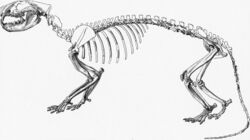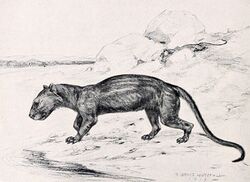Biology:Oxyaena
| Oxyaena | |
|---|---|

| |
| Oxyaena lupina skeletal restoration | |
| Scientific classification | |
| Domain: | Eukaryota |
| Kingdom: | Animalia |
| Phylum: | Chordata |
| Class: | Mammalia |
| Order: | †Oxyaenodonta |
| Family: | †Oxyaenidae |
| Subfamily: | †Oxyaeninae |
| Genus: | †Oxyaena Cope, 1874 |
| Type species | |
| †Oxyaena lupina Cope, 1874
| |
| Species | |
| Synonyms[6] | |
|
synonyms of species:
| |
Oxyaena ("sharp hyena")[7] is an extinct genus of placental mammals from extinct subfamily Oxyaeninae within extinct family Oxyaenidae, that lived in Europe, Asia and North America (with most specimens being found in Colorado) during the early Eocene.[8][9]
Etymology
The name of the genus translates as "sharp hyaena" (from grc ὀξύς- (oxús-) 'sharp' and name of hyena genus Hyaena).[10]
Description
The species were superficially cat or wolverine-like, with a flexible body 1 metre (3.3 ft) long, and short limbs. Some species like Oxyaena forcipata were bigger with a body mass estimated to be 20 kg.[11]
Oxyaena had a broad, low skull (20 cm long) with a long facial part and a massive lower jaw, while its body and tail were long and its five-toed limbs were short.
Oxyaenidae, a family of extinct meat-eating mammals, takes its name from this genus. Oxyaenids may have evolved in North or Central America, and tended to have long bodies and tails with short legs. Because of their shape, early studies often compared them to cats, but this body form has evolved many times in small to medium-sized forest-dwelling predators and mixed feeders, such as viverrids, mustelids, and procyonids.
Oxyaena species were plantigrade, treading on the whole surface of their soles. For this reason, these animals could not have specialized in chasing down fast-running prey. Early studies disagreed on whether they were walking, climbing, or swimming animals; more recent work suggests that like modern raccoons, they may have been able to climb trees, swim, and make a living on the ground, but were not highly specialized in any direction.[12] An analysis of the teeth shows they were generalized feeders, like most modern raccoons and bears, rather than hypercarnivores like modern cats. The overall shape of the feeding equipment in Oxyaena was most similar to the Pleistocene bear Arctodus, which has been reconstructed as eating a range of foods similar to modern brown bears, with a preference for meat.[13] Oxyaena species had a similar size range as modern otters, so they would have hunted small to medium-sized prey, as well as eating some other foods such as insects, crustaceans, and fruit.
In the early Eocene of Wyoming, Oxyaena lived among early rodents, a variety of lemur-like tree-dwellers, pantodonts, and early relatives of horses and tapirs, as well as many other small to mid-sized predators and mixed feeders, including aquatic species (Paleosinopa). The fossil evidence shows that at least in Wyoming, Oxyaena lived in forests or along the margins of forest lakes and streams, and was flexible enough in its habits to survive significant changes in the environment.[14]
References
- ↑ Cope, E. D. (1874.) "Report upon vertebrate fossils discovered in New Mexico, with descriptions of new species." Chief of Engineers Annual Report. U. S. Government Printing Office, Washington, Appendix FF:589-606.
- ↑ W. D. Matthew and W. Granger. (1915.) "A revision of the Lower Eocene Wasatch and Wind River faunas." Bulletin of the American Museum of Natural History 34(1):1-103
- ↑ R. H. Denison. (1937.) "The broad-skulled Pseudocreodi." Annals of the New York Academy of Sciences 37:163-257
- ↑ L. Van Valen. (1966.) "Deltatheridia, a new order of Mammals." Bulletin of the American Museum of Natural History 132(1):1-126
- ↑ Lange-Badré, B. and Godinot, M. (1982). "Sur la présence du genre Arfia Van Valen (Creodonta, Mammalia) dans la faune de Dormaal (Éocène inférieur de Belgique)." Comptes Rendus de l'Académie des Sciences, Série 2, 294: 471-476
- ↑ J. Alroy. (2002.) "Synonymies and reidentifications of North American fossil mammals."
- ↑ "Glossary. American Museum of Natural History". https://research.amnh.org/paleontology/perissodactyl/concepts/glossary.
- ↑ Gingerich, Philip D. (1980). "Tytthaena parrisi, Oldest Known Oxyaenid (Mammalia, Creodonta) from the Late Paleocene of Western North America". Journal of Paleontology 54 (3): 570–576. ISSN 0022-3360. https://www.jstor.org/stable/1304200.
- ↑ Benes, Josef (1979.) "Prehistoric Animals and Plants." Pg. 203. Prague: Artia
- ↑ Dixon, Dougal (2008). World Encyclopedia of Dinosaurs & Prehistoric Creatures. Lorenz Books. ISBN 978-0754817307.
- ↑ Gunnel, Gregg F.; Gingerich, Philip D. (1991). "Systematics and evolution of late Paleocene and early Eocene Oxyaenidae (Mammalia, Creodonta) in the Clarks Fork Basin, Wyoming". Contributions from the Museum of Paleontology (The University of Michigan) 28 (7): 141–180. http://deepblue.lib.umich.edu/bitstream/2027.42/48543/2/ID397.pdf.
- ↑ Gebo, Daniel L.; Rose, Kenneeth D. (1993). "Skeletal Morphology and Locomotor Adaptation in Prolimnocyon atavus, an Early Eocene Hyaenodontid Creodont". Journal of Vertebrate Paleontology 13 (1): 125–144. doi:10.1080/02724634.1993.10011492. ISSN 0272-4634. Bibcode: 1993JVPal..13..125G. https://www.jstor.org/stable/4523490.
- ↑ Wesley-Hunt, Gina D. (2005). "The Morphological Diversification of Carnivores in North America". Paleobiology 31 (1): 35–55. doi:10.1666/0094-8373(2005)031<0035:TMDOCI>2.0.CO;2. ISSN 0094-8373. https://www.jstor.org/stable/4096983.
- ↑ Chew, Amy E. (2009). "Paleoecology of the Early Eocene Willwood Mammal Fauna from the Central Bighorn Basin, Wyoming". Paleobiology 35 (1): 13–31. doi:10.1666/07072.1. ISSN 0094-8373. Bibcode: 2009Pbio...35...13C. https://www.jstor.org/stable/20445619.
Wikidata ☰ Q1084982 entry
 |


